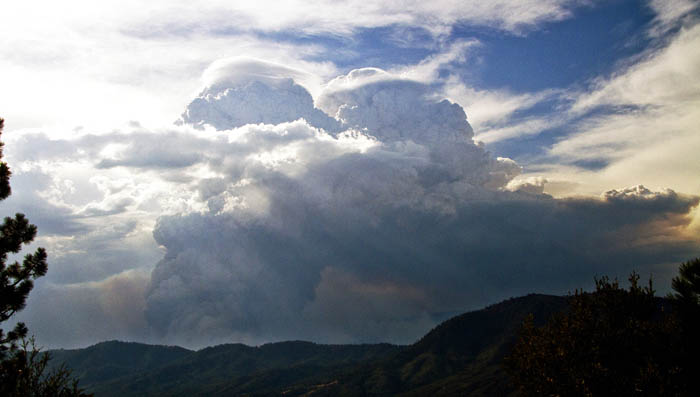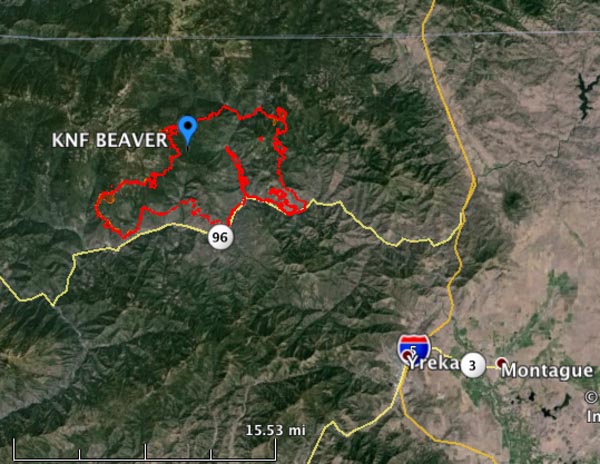
(Updated at 7:15 p.m. August 12, 2014)
The three firefighters who were entrapped and deployed fire shelters were removed from the fireline and transported to a hospital in Yreka, California Monday evening, according to Corey Wilford, a spokesperson for the Incident Management Team (IMT). He said all three were treated for symptoms of smoke inhalation and one of them had second degree burns on his lower leg. After treatment, they were all released from the hospital.
The area that the IMT had previously described as a “safety zone”, did not meet the definition, in that fire shelters were required. On the other hand, the three firefighters had previously observed the area and remembered that it could serve as a “deployment site”, meaning that firefighters could likely survive being burned over at that location, but they would need to deploy fire shelters.
****
(Originally published at 8:44 a.m. PDT, August 12, 2014)
Three firefighters were entrapped by advancing flames Monday afternoon on the Beaver Fire in northern California, approximately 15 miles northwest of Yreka.
The incident occurred at 5:30 p.m. as a rapid wind shift affected the fire. All three firefighters deployed their fire shelters in a predetermined safety zone. They were evaluated on scene and no serious injuries were reported.
All firefighters on the fire were actively withdrawing as a thunderstorm approached. The weather system east of the Beaver Fire produced 30 to 35 mph outflow winds that changed direction rapidly and caused extreme fire behavior. With the increase in wind speed, flame lengths extended into the canopy of the trees, causing a sustained crown run which aligned with the exposed west slope on Buckhorn Ridge.

The lightning-caused Beaver Fire was discovered on June 30 and has blackened 28,000 acres. It is burning in a very remote area and could be a long-duration event. The Incident Management Team is calling it 30 percent contained.
The fire area is under a Red Flag Warning on Tuesday.

The official explanation was a thunderstorm out flow event. I took the picture and don’t recall any storms to the east of the fire. I’ve sent Bill a broader view of the fire just as I arrived on Humbug Ridge at 5:30 PM. I’m thinking it was a collapsed column, not a thunderstorm. If there had been a cell behind the smoke in the shot, the winds wouldn’t have been out of the east.
We just added a photo of a convection column over the Beaver Fire. The photographer said it was taken at about the same time the three firefighters were entrapped.
Bill, do they figure the column collapsed when they deployed?
I know they said that they had out flow winds around 25, 30 mph.
Beautiful shot by the way.
In regards the comment in this comment section about deployment and safety zones, some people might fail to understand about ember wash and radiant heat and super-heated gasses that can hit even the blackest of black depending on how the wind is pushing and convection is pulling. I am aware of instances where even people in adequately-sized safety zones (as per Dr. Butler’s most recent standards) dove into their shelters. In my experience Dr. Bulter’s most recently revised safety zone guidance still allows for safety zones that are too small to protect against heated air, gases, and ember wash or ash. The Beaver Fire incident would not be the first time that shelters have been used despite being in an adequately-sized (at least by Butler’s standards) safety zone. Who are we to second guess the guys and gals who are watching fire come at them and second-guessing their safety zone? I’d rather be safe than sorry.
Let’s encourage folks to use their shelter when they have even a bit of a bad feeling about their safety zone rather than finding out the hard way that Butler’s guidance was wrong and their otherwise ‘appropriately’ sized safety zone was a bit short in terms of lung-searing heat or some such. The initial comment above only serves to stigmatize shelter usage.
Their are a few old-timers who go around to these blogs bragging that they never needed to use a shelter, or making demeaning comments about safety and planning, and those folks are not really helping safety efforts by criticizing. We do not have 100% certain numbers in terms of the possible reach (into the interior of a safety zone) of choking smoke, ember wash, super-heated gases, or gases hot enough to make a guy think he is going to smother. Until we do let’s not criticize ground pounders on the line who feel unsure enough about a safety zone to want to get into a shelter, as an extra measure of protection. Safety first.
Well said, Mr. Benedict, well said and thank you.
No-one was trying to criticize here. Just a simple question thats all. I do agree with what you are saying. So many factors go into what is and what isn’t considered a “safety Zone”. Nor do I feel that it takes a room full of so-called “annalists” to tell me what is. It was only a simple question. I do believe the current system has failed us by only listing FLAME height. Like you said, there are many factors, brands, wind, human, etc. One day we will all live in a perfect world when no-one is harmed. Until then, keep your head on a swivel, your nose in the dirt and trust the one’s watching your back. Stay safe, Sir.
Just to be clear, the current safety zone guidelines developed most recently in May by Dr. Bret Butler only require the following inputs: slope, height of vegetation, and wind speed, plus a number that is always the same, or constant; “8”.
We updated the article with information about the condition of the three firefighters.
Let’s be patient to judge. Everyone is okay and that is what matters. I know someone that was involved in a shelter deployment- they stated the order to deploy was issued simply because rookies were scared of the fire behavior even though they were in a great safety zone. This individual stated people were very seriously considering making a run for another area which was a poor idea. The order to deploy was made to keep the group together and accounted for. Not an ideal situation, but every one was fine and the group didn’t scatter.
Who deployed? My husband is on that fire and have not heard from him.
Everyone heading to the fireline should take time an review the new work by Dr. Brett Butler at the Missoula Fire Lab on Safety Zone minimum sizews – it’s enlightning, but scary too!
“Three firefighters were entrapped by advancing flames…”
“The incident occurred at 5:30 p.m. as a rapid wind shift affected the fire”
“All firefighters on the fire were actively withdrawing as a thunderstorm approached.”
“The weather system east of the fire produced 30 to 35 mph outflow winds that changed direction rapidly and caused extreme fire behavior.”
“With the increase in wind speed, flame lengths extended into the canopy of the trees, causing a sustained crown run which aligned with the exposed west slope ”
Sounds all too familiar….
Cap hit the nail on the head, why did they have to deploy in a “Safety Zone”? Im guessing that it was a pre-determined deployment site and not a safety zone. Glad they are ok; we still win if we all go home.
All I can say is thank God they were OK. But a question I am curious about with out being critical or to judge in any way. But, Isn’t a “safety zone” a place determined that in the event you could stay safe without the use of a shelter? I am genuinely curious to see the report. Its easy to arm chair quarterback these things when you are not the one that readily experienced the environment they were in. Human factors play a huge role. Once again, I am glad to hear all turned out OK.